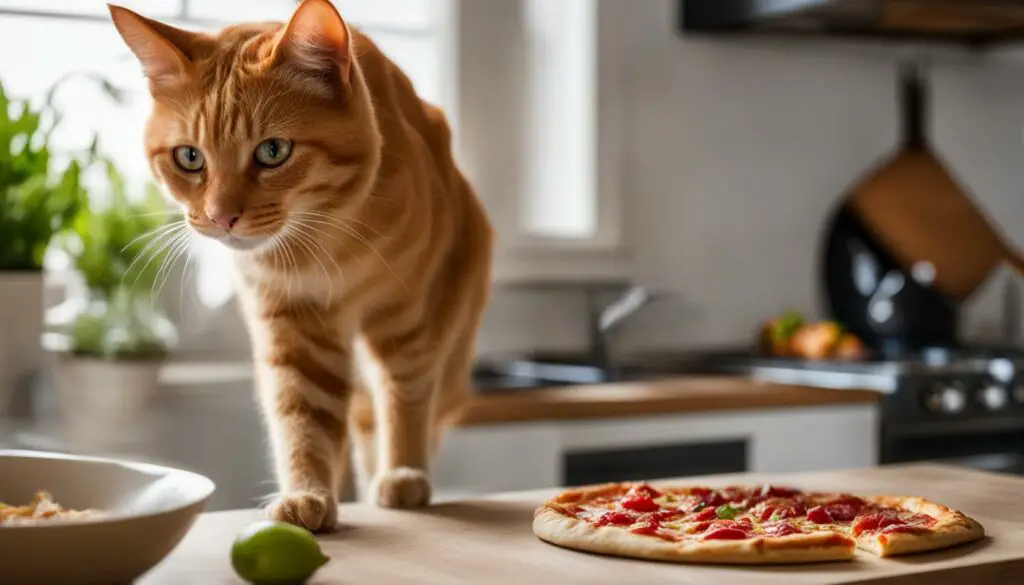As a cat owner, I’ve often wondered why my feline friend has a penchant for human food. It’s a common behavior that many cat owners can relate to. But what drives this curious attraction? Let’s delve into the fascinating world of feline behavior and explore the reasons behind their interest in human food.
Key Takeaways:
- Cats’ preference for human food is a common behavior among cat owners.
- Understanding the reasons behind this behavior can help manage their diet and ensure their health.
- Research on feline behavior provides insights into why cats may be attracted to human food.
- Cats can safely eat certain fruits, vegetables, meats, and fish in moderation.
- There are human foods that are toxic and harmful to cats and should be strictly avoided.
The Psychology of Cats: Exploring Feline Behavior
Understanding why cats are attracted to human food involves delving into the fascinating realm of feline behavior. Associate Professor Arii Watanabe of Chiba University is conducting groundbreaking research on the psychology of animals, including cats. Through her behavioral experiments, she aims to shed light on whether animals, like cats, possess consciousness similar to humans and are aware of their own thought processes. This research not only contributes to a better understanding of feline behavior but also offers valuable insights into why cats may be drawn to human food.
Cats, like many animals, have retained certain instincts and behaviors from their wild ancestors, such as the African wildcat. These ancestral traits, including hunting and territorial instincts, can influence their attraction to human food. Furthermore, cats possess a unique sensory world that differs from our own. Their keen senses of vision, hearing, and smell contribute to their curiosity towards human food. Cats’ ability to see in low-light conditions, hear faint sounds, and detect a wide range of scents make them naturally inclined to explore different tastes and textures.
It’s important to note that cats are not purely solitary creatures. They can form strong bonds with their human companions, engaging in complex social behaviors. The shared experience of food can be seen as a way for cats to connect with their humans, as they perceive it as a part of their social relationship.
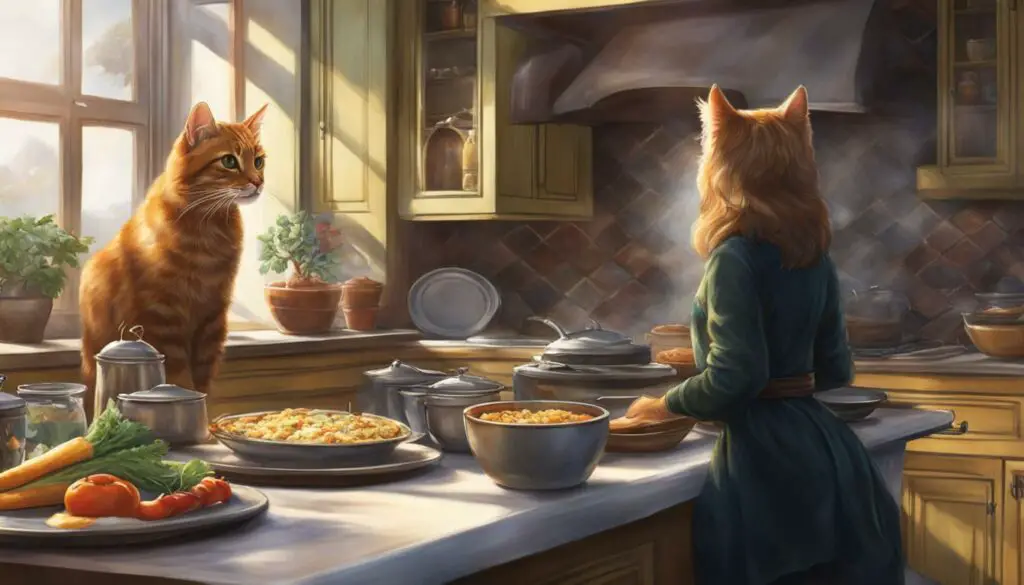
In summary, cats’ attraction to human food can be attributed to a combination of evolutionary instincts, sensory experiences, and social behavior. While it is natural for cats to be curious about human food, it is crucial for pet owners to provide a balanced and species-appropriate diet. Understanding the underlying reasons for cats’ interest in human food can help owners manage their cats’ diet effectively and ensure their health and well-being.
Cats and Human Food: The Challenges of Research
Research on the impacts of feeding cats human food and the consequences of letting them eat our food has posed several challenges for scientists. Cats, unlike dogs, are less cooperative when it comes to participating in experiments, making it difficult for researchers to study their behavior and understand the effects of human food on their health. This has led to limited knowledge in this area, but ongoing research is striving to provide valuable insights.
One of the primary challenges in studying cats and their attraction to human food is their refusal to willingly participate in experiments. Cats have a high level of independence and may not display the same level of cooperation as dogs in controlled settings. As a result, researchers have to employ alternative methods and techniques to gather data, such as observational studies and surveys filled out by cat owners.
Another challenge is the potential variation in cats’ responses to different types of human food. Just like humans, cats have individual preferences, and their interest in certain foods may vary. This makes it challenging to draw general conclusions about cats’ overall attraction to human food based on limited studies.
| Challenges of Research on Cats and Human Food |
|---|
| Reluctance of cats to participate in experiments |
| Variation in cats’ responses to different human foods |
| Dependency on observational studies and surveys |
“Studying the impacts of feeding cats human food is a complex undertaking due to the uncooperative nature of these feline companions. It requires innovative research methods and a deep understanding of their individual preferences. While challenging, ongoing research aims to provide valuable insights into managing cats’ desire for human food and ensuring their overall well-being.”
What Cats Can Safely Eat: Fruits and Vegetables
While cats are obligate carnivores and require a diet rich in animal protein, they can safely eat certain fruits and vegetables in moderation. Some safe options include apples, bananas, pears, blueberries, strawberries, and pumpkin. These foods should be fed in small quantities and without seeds, stems, skin, or pits, as these can pose choking hazards.
Offering these fruits and vegetables as occasional treats can help satisfy a cat’s curiosity towards human food while ensuring their nutritional needs are met. It’s important to note that a cat’s digestive system is not designed to process large amounts of plant material, so these fruits and vegetables should only be given in small portions.
So, the next time you want to share a snack with your feline friend, consider offering them a small piece of fruit or vegetable that is safe for their consumption. Just remember to keep it as a special treat and not as a regular part of their diet.
| Fruits | Vegetables |
|---|---|
| Apples | Pumpkin |
| Bananas | Carrots |
| Pears | Green beans |
| Blueberries | Peas |
| Strawberries |
“Offering these fruits and vegetables as occasional treats can help satisfy a cat’s curiosity towards human food while ensuring their nutritional needs are met.”
Remember, always consult with your veterinarian before introducing any new foods into your cat’s diet. They can provide guidance on portion sizes, frequency, and ensure that your cat’s specific dietary needs are met. It’s also important to note that some cats may have sensitivities or allergies to certain fruits and vegetables, so it’s best to monitor their reaction when introducing new foods.
Meat and Fish: A Natural Desire for Protein
When it comes to satisfying their taste buds, cats have a natural desire for protein-rich foods. As obligate carnivores, their bodies are designed to thrive on diets that primarily consist of meat and fish. While it’s important to provide cats with a balanced and complete commercial cat food, offering occasional plain, lean meats or fish as treats can be a great way to cater to their carnivorous instincts.
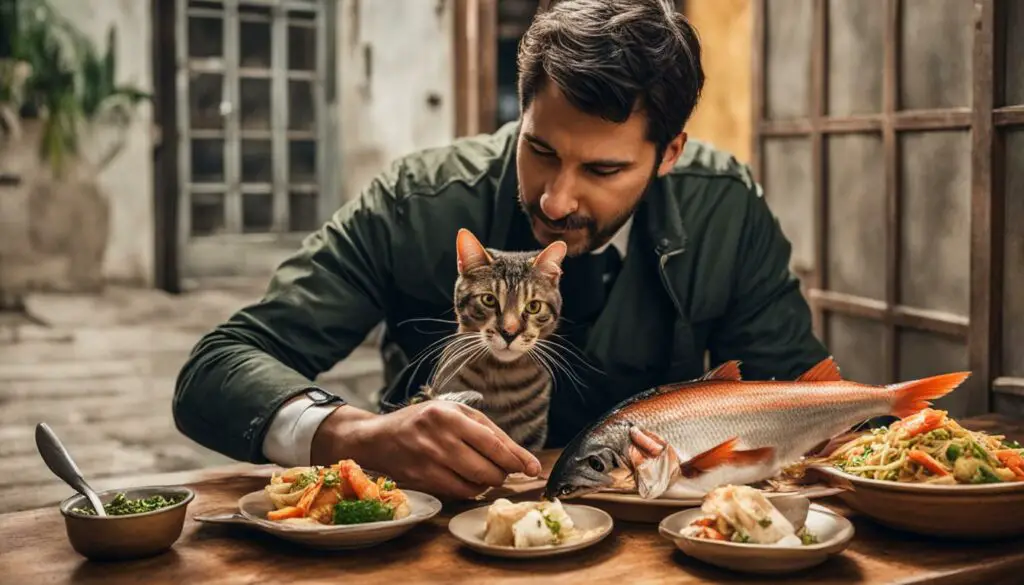
Cooked options such as beef, chicken, turkey, liver, sardines, tuna, salmon, and shrimp can be safe choices. However, it’s crucial to avoid seasoning the meat and to ensure that it is thoroughly cooked to eliminate any potential health risks. By incorporating small portions of lean meat or fish into their diet, cat owners can provide their feline companions with a source of high-quality protein that aligns with their natural dietary preferences.
Benefits of Meat and Fish:
- High-quality protein: Meat and fish are rich sources of essential amino acids that cats need for optimal health and muscle development.
- Omega-3 fatty acids: Certain types of fish, such as salmon and tuna, contain omega-3 fatty acids that promote a healthy coat and skin.
- Dental health: Chewing on meat and fish can help maintain healthy teeth and gums by reducing plaque and tartar buildup.
Precautions:
- Quantity control: Treats should make up no more than 10% of a cat’s daily caloric intake to avoid nutritional imbalances.
- Hygiene and food safety: Ensure that the meat or fish is fresh, properly cooked, and free from any bones or potentially harmful seasonings.
- Veterinary consultation: It’s always a good idea to consult with a veterinarian before introducing any new foods or treats into a cat’s diet to ensure they are suitable for their individual needs.
Offering small portions of meat or fish as occasional treats can not only satisfy a cat’s natural desire for protein but also add variety and excitement to their diet. By responsibly managing their access to these foods and following proper safety guidelines, cat owners can provide a balanced and enjoyable dining experience for their feline friends.
Dairy Delicacies: The Surprising Exception
When it comes to cats and human food, one might assume that dairy products are off-limits due to their lactose intolerance. However, there is a surprising exception to this rule – plain and unsweetened yogurt. Yogurt contains bacteria that break down lactase, a naturally occurring sugar in milk, making it more digestible for cats. It can be a safe and occasional addition to their diet, providing them with probiotics and essential nutrients.
Before introducing yogurt or any dairy products into a cat’s diet, it’s crucial to consult with a veterinarian. They can assess the cat’s specific dietary needs and advise on the appropriate portion size and frequency of yogurt consumption. It’s also important to choose plain yogurt without any added flavors, sweeteners, or artificial additives that may be harmful to cats.
While plain and unsweetened yogurt can be beneficial for some cats, it’s essential to understand that not all cats may tolerate dairy products well. Some cats may still experience digestive issues or allergic reactions even with plain yogurt. Monitoring the cat’s response to yogurt and seeking veterinary guidance is essential to ensure their overall health and well-being.
As with any changes to a cat’s diet, it’s important to introduce new foods gradually and in moderation. Yogurt can be offered as an occasional treat or mixed with their regular food to provide a variety of flavors and textures. By carefully managing a cat’s desire for human food, including the surprising exception of yogurt, owners can promote their cat’s health and happiness.
| Dairy Delicacies | Safe for Cats | Potential Benefits |
|---|---|---|
| Plain Yogurt | Yes | – Provides probiotics |
| Milk | No | – Cats are lactose intolerant |
| Cheese | No | – Can be high in fat and salt |
| Ice Cream | No | – Contains sugar, additives, and potential allergens |
Conclusion:
While cats may be curious about human food, it’s crucial for pet owners to manage their desire and provide them with a balanced and species-appropriate diet. Dairy products like plain and unsweetened yogurt can be a surprising exception, offering potential benefits for cats. However, it’s essential to consult with a veterinarian before introducing any new foods into a cat’s diet to ensure their overall health and well-being. By understanding and addressing their behavioral and dietary preferences, pet owners can create a harmonious and healthy relationship with their feline companions.
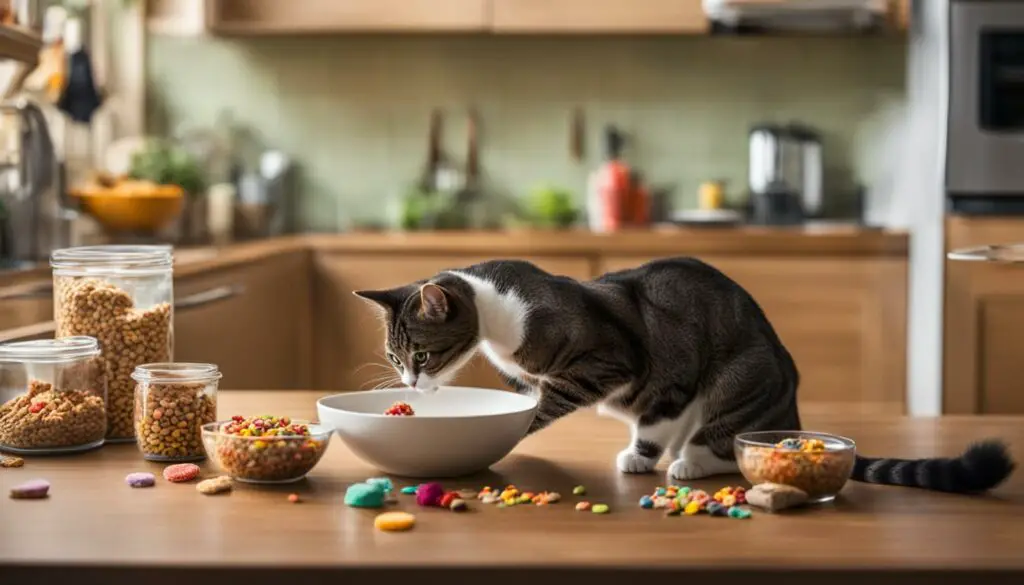
Understanding Cats’ Interest in Human Food
When it comes to understanding why cats are interested in human food, there are several factors to consider. Cats have a natural curiosity and exploration instinct, which can lead them to investigate different types of food, including those meant for humans. Additionally, their heightened senses of smell and taste may make human food particularly enticing for them. However, as responsible pet owners, it is crucial to manage their desire for human food to ensure their health and well-being.
To effectively manage cats’ interest in human food, it is important to provide them with a balanced and species-appropriate diet. While small quantities of certain fruits and vegetables, cooked meats or fish, and even cereals and grains can be given as occasional treats, it is essential to avoid toxic or harmful substances. Foods such as grapes, onions, garlic, chocolate, and alcohol should never be given to cats, as they can cause serious health issues.
| Safe Foods in Moderation | Foods to Avoid |
|---|---|
| Apples | Grapes and Raisins |
| Bananas | Onions |
| Pears | Garlic |
| Blueberries | Chocolate |
| Strawberries | Alcohol |
| Pumpkin | |
| Lean Meats (cooked) | |
| Fish (cooked) | |
| Oatmeal (cooked) | |
| Rice (cooked) |
By offering a variety of safe, occasional treats in moderation and ensuring a balanced commercial cat food as their main diet, we can satisfy their curiosity while meeting their nutritional needs. It’s also important to create an enriching environment for them, including toys, scratching posts, and interactive play sessions, to keep them mentally stimulated and help redirect their attention away from human food.
Remember, every cat is unique, and it’s essential to consult with a veterinarian to understand their specific dietary requirements and any health concerns. With proper management and care, we can foster a healthy and happy relationship with our feline companions while ensuring their well-being.
Foods to Avoid: Toxic and Harmful Substances
When it comes to feeding your feline companion, it’s essential to be aware of the foods that can be toxic or harmful to them. While cats may show a curiosity towards human food, there are certain items that should never be given to them under any circumstances.
Table: Foods to Avoid
| Foods | Potential Health Issues |
|---|---|
| Grapes and Raisins | Kidney damage |
| Oranges | Upset stomach |
| Cherries, Plums | Respiratory distress |
| Onion, Garlic, Mushrooms | Anemia, gastrointestinal upset |
| Raw Fish or Meat, Cooked Bones | Bacterial contamination, choking hazards |
| Milk, Cheese, Ice Cream | Lactose intolerance, digestive issues |
| Xylitol, Nuts, Alcohol | Toxicity, liver damage |
| Caffeine, Chocolate | Central nervous system stimulation, heart issues |
| Raw Dough | Gastrointestinal distress, alcohol production |
These foods can cause a range of health issues, from gastrointestinal upset to organ damage. It’s crucial to keep them out of your cat’s reach and never intentionally offer them these items. If you suspect that your cat has ingested any of these harmful substances, it’s important to seek veterinary care immediately.
Remember, providing a balanced and species-appropriate diet is key to ensuring your cat’s health and well-being. By understanding the reasons behind cats’ attraction to human food and being aware of the foods to avoid, you can keep your feline friend safe and satisfied with a diet that meets their nutritional needs.
Feline Evolution: Unraveling the Instincts
Cats’ fascination with human food can be traced back to their evolutionary history. Domestic cats have evolved from wild ancestors like the African wildcat, and certain behaviors and instincts have been retained from their feral counterparts. These ancestral traits play a significant role in their attraction to human food.
One key instinct that influences cats’ interest in human food is their innate hunting behavior. In the wild, cats are skilled predators, hunting small animals for their sustenance. The taste and smell of human food can trigger their hunting instincts, as it resembles the scents and textures of prey. This primal instinct drives their curiosity towards exploring and tasting different types of food, including those meant for humans.
Additionally, territorial instincts also contribute to cats’ attraction to human food. Cats mark their territory through scent marking, and the presence of food, especially food associated with their human companions, can be perceived as a shared resource. This can trigger their desire to investigate and potentially claim the food as their own.
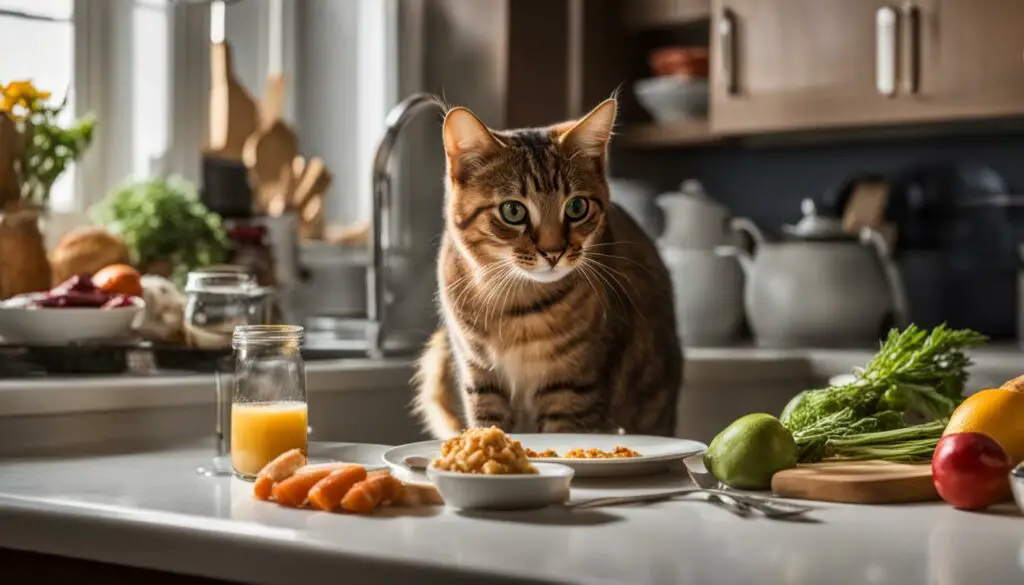
Table: Evolutionary Influences on Cats’ Attraction to Human Food
| Evolutionary Factor | Influence on Cat Behavior |
|---|---|
| Hunting Instincts | Triggers curiosity towards exploring and tasting different types of food. |
| Territorial Instincts | Perceives human food as a shared resource and may investigate and claim it. |
Understanding these evolutionary influences can help pet owners better manage their cats’ behavior around human food. By providing appropriate outlets for their hunting and territorial instincts, such as interactive toys and designated feeding areas, owners can help satisfy their cats’ natural urges while ensuring their safety and well-being.
The Senses of Cats: A Different Perception
Cats possess a unique sensory world that shapes their perception of the world around them, including their attraction to human food. Their keen senses of vision, hearing, and smell contribute to their curiosity and exploration of different types of food. Cats have exceptional night vision, allowing them to see clearly in low-light conditions. This ability may drive their interest in investigating the scents and textures of human food, as they can visually assess it even in dimly lit environments.
In addition to their visual acuity, cats have powerful hearing that enables them to detect a wide range of sounds. They may be enticed by the rustling of food packaging or the sound of utensils clinking against plates, drawing them closer to investigate the source of these intriguing noises. Their acute sense of smell further enhances their interest in human food, as they can pick up subtle odors and distinguish different flavors with great precision.
The unique sensory experiences of cats are an integral part of their natural instincts and behavior. Understanding their heightened senses can help explain their fascination with human food and their desire to explore and interact with it. By providing a stimulating environment that engages their senses in a species-appropriate manner, pet owners can help satisfy their cats’ curiosity and provide alternative outlets for their sensory needs.
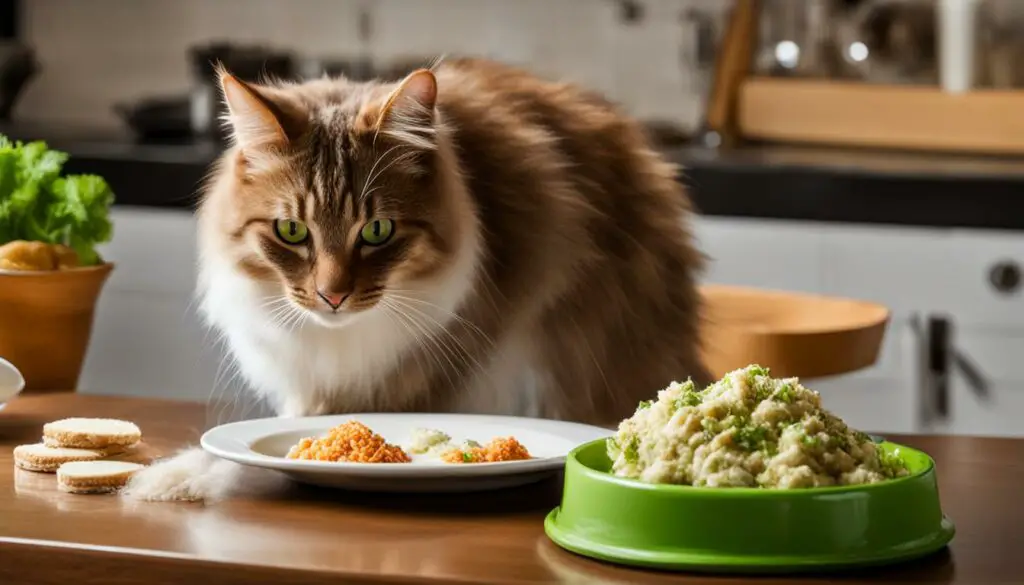
Table: A Comparison of Human and Feline Senses
| Human Senses | Cat Senses | |
|---|---|---|
| Vision | Good color vision and visual acuity | Exceptional night vision; limited color vision |
| Hearing | Can hear a wide range of frequencies | Can detect faint sounds and high frequencies |
| Smell | Can distinguish a variety of scents | Keen sense of smell; can detect subtle odors |
| Taste | Complex taste receptors | Similar taste receptors to humans |
| Touch | Sensitive to pressure, temperature, and pain | Well-developed sense of touch; sensitive whiskers |
The table above provides a comparison of human and feline senses, highlighting the unique abilities of cats. While cats may have limitations in some areas, such as color vision, their heightened night vision and acute hearing and smell compensate for these differences. These enhanced sensory capabilities contribute to their curiosity towards human food and their ability to explore and interact with their environment in distinctive ways.
Feline Attraction to Human Food: Understanding Cats’ Interest
When it comes to our feline friends, their attraction to human food is a behavior that many cat owners have observed. This curiosity can range from a simple fascination to a strong desire to sample the flavors we enjoy. To better comprehend this aspect of feline behavior, it is essential to explore the underlying factors that contribute to cats’ interest in human food.
One possible explanation lies in cats’ natural instincts. As descendants of wild hunters, they have an innate drive to explore new tastes and textures. This curiosity extends to the unfamiliar scents and flavors present in human food. Additionally, cats’ heightened sense of smell plays a significant role in their attraction to the aromas emanating from our meals.
Another factor is the social aspect. Cats often observe their human companions enjoying food and perceive it as a shared experience. This connection and the desire to be part of the social dynamic can fuel their curiosity towards human food. It is important for pet owners to understand that this interest in human food does not necessarily stem from hunger or a nutritional deficiency but rather from a combination of instinctual and social factors.
To manage cats’ desire for human food, it is crucial to provide a balanced and species-appropriate diet. Consulting with a veterinarian can help determine the best approach to meet their nutritional needs while ensuring their overall health and well-being. By understanding the underlying reasons behind cats’ attraction to human food, pet owners can better navigate their feline companions’ culinary curiosities.
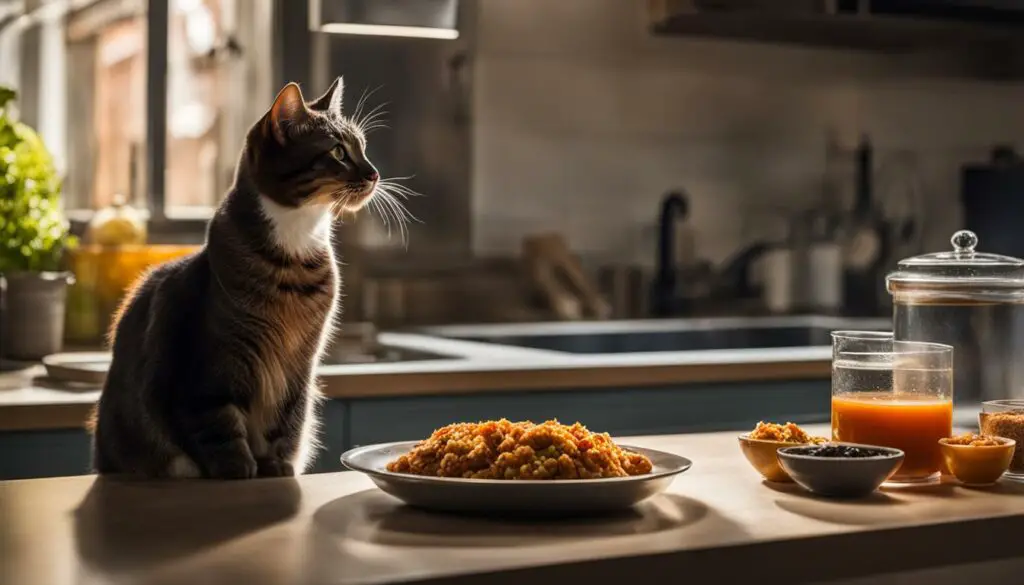
The Table:
| Factors Influencing Cats’ Interest in Human Food | Description |
|---|---|
| Natural Instincts | Cats’ ancestral hunting instincts drive their curiosity towards new tastes and textures. |
| Heightened Sense of Smell | Cats’ keen sense of smell amplifies their attraction to the aromas of human food. |
| Social Connection | Cats perceive the social aspect of food and desire to be part of the shared experience. |
| Not Related to Hunger | Cats’ interest in human food is not necessarily indicative of hunger or nutritional deficiencies. |
| Importance of Proper Diet | Consulting with a veterinarian ensures cats receive a balanced and species-appropriate diet. |
Cognitive Abilities: Unleashing the Cat’s Intelligence
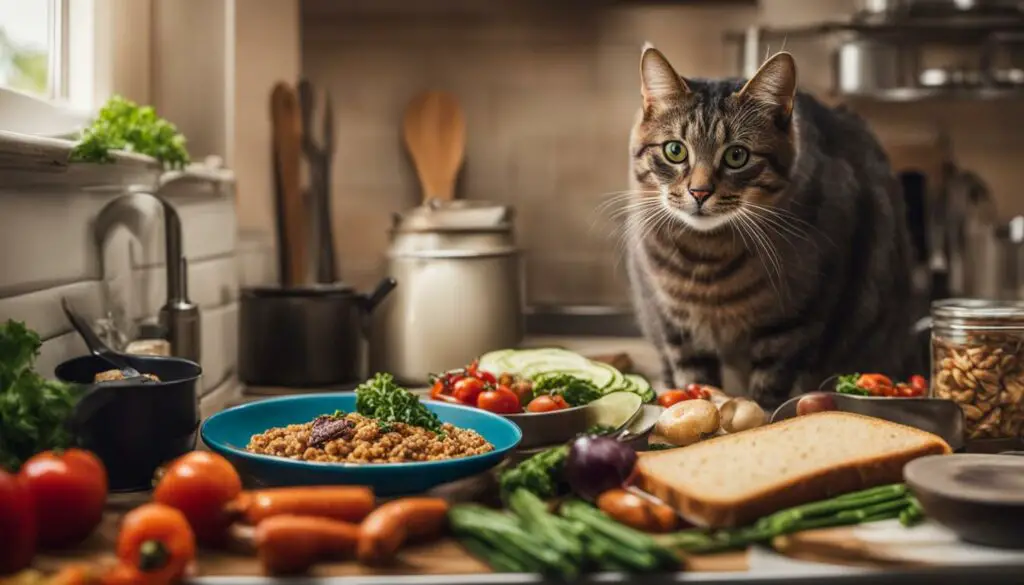
When it comes to cat behavior with human food, there is much more than meets the eye. Cats possess a range of cognitive abilities that contribute to their curiosity and exploration of different tastes and textures. Studies have shown that cats have remarkable problem-solving skills and can learn from past experiences, showcasing their intelligence in various situations.
Their memory capabilities allow them to remember where food sources are located and navigate their surroundings effectively. Cats also exhibit spatial awareness and an understanding of cause-and-effect relationships, enabling them to manipulate objects and solve puzzles.
Scientists theorize that these cognitive abilities are deeply ingrained in their evolutionary history as hunters. By unraveling the mysteries of their intelligence, we gain a greater appreciation for their prowess and the reasons behind their fascination with human food.
Emotional Well-being: The Impact on Food Preferences
Understanding the reasons behind cats eating human food involves delving into various aspects of their behavior and well-being. One crucial factor that influences their food preferences is their emotional well-being. Cats, like humans, experience a range of emotions, and their emotional state can significantly impact their attraction to human food. It’s important for cat owners to recognize the link between emotional well-being and food preferences to ensure their feline companions’ overall health and happiness.
Cats are sensitive creatures, and their emotional well-being is influenced by various factors such as their living environment, social interactions, and daily routines. A stable and enriching environment, along with consistent routines, can contribute to a cat’s emotional stability and contentment. On the other hand, stress, anxiety, or feelings of discomfort can lead to changes in their eating behaviors, including a heightened interest in human food.
To maintain a cat’s emotional well-being and manage their desire for human food, it is important for cat owners to provide a nurturing environment that includes appropriate mental and physical stimulation. Engaging in interactive play sessions, providing scratching posts, and creating safe spaces for relaxation can help alleviate stress and keep cats emotionally balanced. Understanding and addressing their emotional needs can reduce their inclination towards seeking out human food as a substitute for emotional fulfillment.
Table: Factors Affecting Cats’ Emotional Well-being and Food Preferences
| Factors | Impact on Emotional Well-being | Impact on Food Preferences |
|---|---|---|
| Environmental Enrichment | Creates a stimulating and engaging environment, reducing stress and boredom | Reduces the likelihood of seeking alternative food sources due to emotional discomfort |
| Socialization | Promotes positive social interactions and a sense of security | Reduces stress-related behaviors, such as emotional eating |
| Consistent Routines | Provides predictability and familiarity, contributing to a sense of stability | Reduces the likelihood of food-related anxiety or seeking out human food |
| Stressful Environments | Can lead to heightened anxiety and emotional discomfort | May result in increased interest in human food as a coping mechanism |
Cats’ interest in human food should be viewed as a potential indicator of their emotional well-being. By addressing their emotional needs and providing a nurturing environment, cat owners can help reduce their cats’ inclination towards human food and ensure their overall health and happiness.
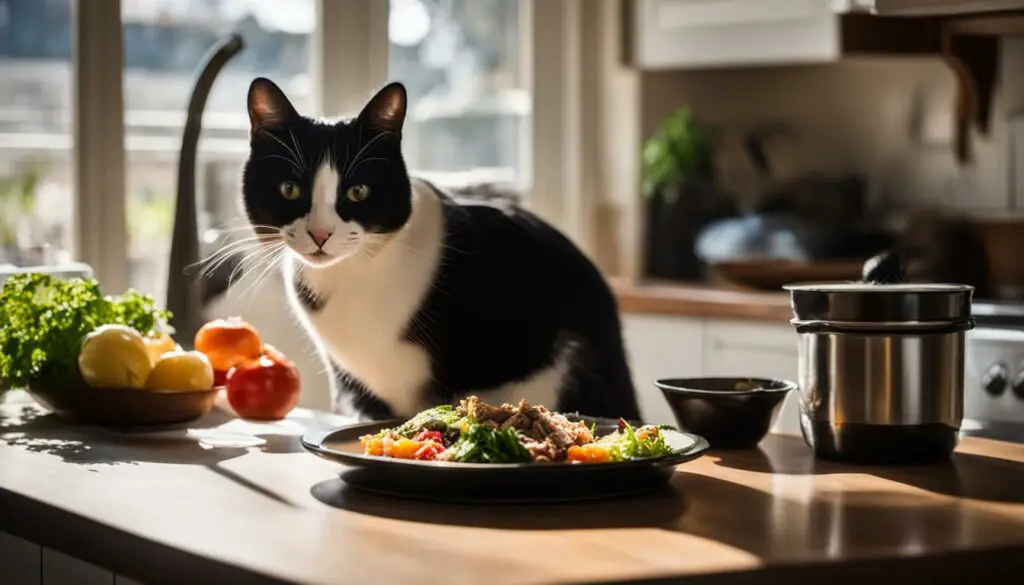
Conclusion
So, why does my cat like human food? Well, it turns out that cats’ curiosity towards our food stems from a combination of factors. Their evolutionary background, sensory experiences, social behavior, cognitive abilities, and emotional well-being all play a role in their attraction to the smells and tastes of human food.
While it’s natural for cats to be curious about what we’re eating, it’s important for us as pet owners to prioritize their health and well-being. Providing a balanced and species-appropriate diet is crucial to ensuring that our feline companions receive the necessary nutrients they need. Consulting with a veterinarian can help us better understand and manage their interest in human food.
By addressing their behavioral and dietary preferences, we can create a harmonious and healthy relationship with our cats. Remember, their curiosity towards human food is just one aspect of their fascinating behavior. So, let’s continue to learn, explore, and cherish our unique bond with these incredible creatures.
FAQ
Why does my cat like human food?
Cats may be attracted to human food due to their innate instincts and curiosity. Understanding their evolutionary background, sensory experiences, social behavior, cognitive abilities, and emotional well-being can help explain their interest in exploring different types of food, including those meant for humans.
How can I manage my cat’s desire for human food?
By providing a balanced and species-appropriate diet, you can help satisfy your cat’s curiosity towards human food. Consultation with a veterinarian is essential for managing their interest in human food and ensuring their nutritional needs are met.
Is it safe for cats to eat fruits and vegetables?
Yes, certain fruits and vegetables can be safely fed to cats in moderation. Some safe options include apples, bananas, pears, blueberries, strawberries, and pumpkin. These foods should be offered in small quantities and without seeds, stems, skin, or pits, as these can pose choking hazards.
Can cats eat meat and fish?
Yes, meat and fish are a vital part of a cat’s diet. While it’s important to feed them a balanced commercial cat food, occasional plain, lean meats or fish can be offered as treats. Safe options include beef, chicken, turkey, liver, sardines, tuna, salmon, and shrimp. It’s important to avoid seasoning and ensure that the meat or fish is cooked thoroughly to avoid any potential health risks.
Can cats consume dairy products?
Cats are generally lactose intolerant and should not consume milk or cheese. However, plain and unsweetened yogurt can be an exception as it contains bacteria that break down lactase, a naturally occurring sugar in milk, making it more digestible for cats. It’s crucial to consult with a veterinarian before introducing yogurt or any dairy products into a cat’s diet.
Are cereals and grains safe for cats?
While cereals and grains are not a natural part of a cat’s diet, small quantities of cooked oatmeal and rice can be given as a source of fiber or minerals. It’s important to serve them plain and without any added sugar, flavorings, or milk.
What human foods should I avoid feeding my cat?
Certain human foods are toxic or harmful to cats and should be strictly avoided. These include grapes and raisins, oranges, cherries, plums, onion, garlic, mushrooms, raw fish or meat, cooked bones, milk, cheese, ice cream, xylitol, nuts, alcohol, caffeine, chocolate, and raw dough. These foods can cause a range of health issues and should never be given to cats.
Why are cats attracted to human food?
Cats’ attraction to human food can be influenced by their evolutionary background, sensory experiences, social behavior, cognitive abilities, and emotional well-being. Understanding these factors can help explain their behavior and dietary preferences.
How do cats perceive the world differently from humans?
Cats possess keen senses of vision, hearing, and smell, which shape their unique perception of the world. Their ability to see clearly in low-light conditions, hear faint sounds, and detect a wide range of scents contributes to their curiosity towards human food.
Can cats form bonds with humans?
Yes, cats can form strong bonds with their human companions and engage in complex social behaviors. The bond between cats and humans is built on trust, affection, and mutual understanding, contributing to their curiosity towards human food as they perceive it as a shared experience.
Do cats have cognitive abilities?
Yes, cats possess remarkable cognitive abilities. They can solve problems, learn from experiences, and exhibit strategic thinking. Their intellectual prowess contributes to their curiosity towards human food as they explore different tastes and textures.
How does emotional well-being impact a cat’s food preferences?
Cats experience a range of emotions, and their emotional well-being can impact their food preferences. Factors such as environmental enrichment, socialization, and consistent routines contribute to their emotional stability and overall happiness, which can influence their interest in human food.

